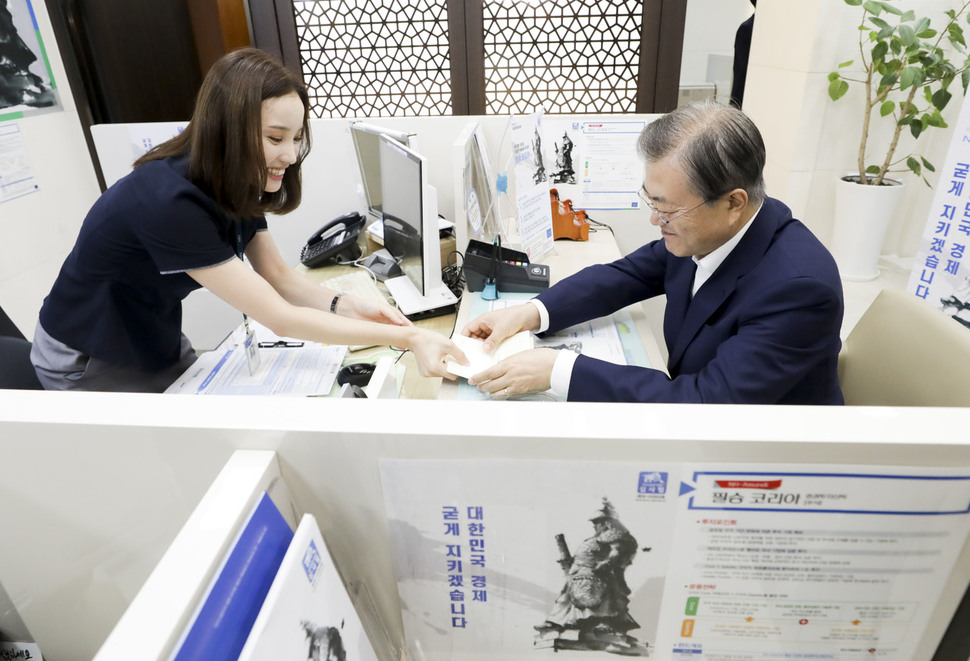 |
|
South Korean president Moon Jae-in is signing up for the “victory Korea fund” at the main office of NH Nonghyup Bank, in downtown Seoul, on the morning of Aug. 26. This fund invests in South Korean small and medium-sized companies in the areas of parts, materials, and equipment. (Blue House photo pool)
|
Seoul resolved to respond calmly as the preordained situation plays out
On Aug. 26, just two days before the Japanese government was set to remove South Korea from its white list of countries that enjoy expedited screening for exports, the South Korean government and the Blue House were reviewing countermeasures for each company and product, in recognition that Japan could impose additional measures. If Tokyo implements the revision to its export and trade management rules on Aug. 28, dropping South Korea from the white list as planned, Japanese companies will be required to receive permits for each product they export to South Korea. Seoul seems determined to respond calmly, in accordance to the plan it has drawn up in case Japan goes ahead with the white list removal. “The Japanese government would have implemented our removal from the white list even if we had extended GSOMIA. That situation was already preordained, so the Ministry of Trade, Industry, and Energy is leading an effort to devise countermeasures in consideration of several potential scenarios for the future,” said a senior official at the Blue House. GSOMIA, or the General Security of Military Information Agreement, was an intelligence-sharing agreement with Japan from which South Korea recently withdrew. “We will respond to changing circumstances by facilitating communication between the government and companies and taking countermeasures for each company and product,” another official at the Blue House said. When asked whether Seoul expects the Japanese government to take additional retaliatory measures, the official said, “That’s a matter for them to decide. It wouldn’t be appropriate for us to make predictions about that.” During a meeting on Monday, South Korea’s ruling Democratic Party and the government agreed to increase budgetary support for the parts, materials, and equipment industry to above 2 trillion won (US$1.65 billion) to counteract Japan’s retaliation. “We have no choice but to expand the budget substantially to counter Japan’s punitive trade measures, which is the greatest issue facing our economy. We’ve also decided to increase the emergency fund in order to respond promptly to additional situational changes,” said Rep. Cho Jeong-sik, chair of the Democratic Party’s policy committee. With Japan ignoring the South Korean government’s efforts to find a diplomatic solution, the Blue House plans to maintain its current campaign to “get the better of Japan,” at least for now. On Monday, South Korean President Moon Jae-in visited the main office of NH Nonghyup Bank, located in downtown Seoul, and invested in a fund launched by NH-Amundi Asset Management that focuses on South Korean companies operating in the areas of parts, materials, and equipment. The bank will be setting aside 50% of its proceeds for the public interest, in order to fund scholarships to promote basic science research. “This is a very good fund that’s donating half of its profit to the parts, materials, and equipment industry. I hope that a lot of Koreans will lend their help since it’s very important to increase our competitiveness in response to Japan’s retaliation,” said Moon, who was investing 50 million won (US$41,200) into the fund. Experts on Japan agree that this crisis should be viewed as a blessing in disguise. “There’s been a lot of talk about a better relationship between big and small companies; cooperation between industry, academia, and the research sector; and government support for the parts and materials industry, but they haven’t been realized yet. This should be regarded as a crucial opportunity to resolve all of those issues at once,” said Kim Hyun-chul, director of the Institute for Japanese Studies at Seoul National University, during an academic conference on Japan in downtown Seoul on Monday. “Our approach to R&D policy should be selecting materials and equipment that will continue to receive support until development is completed and then to move on to other areas,” the director said. Another potential solution, Kim said, is expanding trade with India and the member states of the Association of Southeast Asian Nations (ASEAN) as part of the government’s New Southern Policy. Military wraps up defense exercise on Dokdo In related news, a two-day exercise focusing on the defense of the island of Dokdo wrapped up on Monday. Forces participating in the exercise included 10 ships from the navy and coast guard; 10 aircraft, including the F-15K, the workhorse of the South Korean Air Force; the navy’s elite Maritime Task Flotilla Seven, which includes the ROKS Sejong the Great, a 7,600 ton Aegis guided-missile destroyer; and special forces from the army. Following the exercise, the government will reportedly review the timing and scale of this year’s second Dokdo defense exercise. By Seong Yeon-cheol, Park Min-hee, Lee Wan and Seo Young-ji, staff writers Please direct comments or questions to [english@hani.co.kr]






